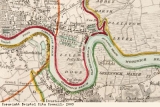South and south east coast of England
The capital city of London was the main slaving port for the south and south-east of England. For 26 years from 1672 to 1698, a London-based trading company, the Royal African Company, was the only one allowed to trade with Africa. This changed in 1698, but London remained the leading slaving port until overtaken by Bristol in the 1730s. London merchants were also involved in trade with the plantations. They supplied the plantation owners with all the things that could not be made on the islands or the American colonies. These were items such as glass, fine china, silk and machinery. Then they would bring back the slave-produced goods like sugar and tobacco. These were processed in the city and encouraged huge new industries to grow. Pictured here is a plan of part of the docks along the River Thames. It shows the East India Dock and the West India Dock. These were so-called after the trade areas with which they dealt. The East Indies trade was with the east, in goods such as tea and spices. The West Indies trade was with the Caribbean islands. Although the slave trade itself was over by the time of this map, the trade in slave-produced goods was still strong.
The town of Deal provided a safe place to anchor at the mouth of the River Thames, down river from London. The ships from London could wait there for orders or good weather before setting off. The town was used by the Royal African Company, the South Sea Company and the East India Company (which were all London-based trading companies). They all kept agents there in the early 18th century. These agents could deal with last-minute supplies for ships. London merchants also used the coastal town of Portsmouth, south of London, to load goods before their ships sailed for Africa. Portsmouth merchants themselves financed two slaving voyages a year from 1758 to 1774.
Weymouth, on the south coast, also had merchants who sent out the occasional voyages to the plantations. Very occasional slaving voyages also left the town. Perhaps the port was too small to organise slaving ships, or perhaps this could have been because the merchants were disappointed by the profits they made.
Lyme Regis on the south coast of Dorset, in the early 18th century was a major port for trade to the plantations in the southern state of Virginia, America. Tobacco was imported to Lyme Regis and sold on to Bristol, London or Rotterdam in Holland. Five slaving voyages were sent out to the West African coast early in the century from the town. Lyme Regis merchants also bought slaves on the Caribbean island of Barbados and sold them to the tobacco plantations in Virginia in America. By the 1750s, Lyme Regis was no longer involved in trade with the Caribbean plantations and Africa. The smaller ports found it difficult to compete with the resources which the larger ports, like Bristol and Liverpool, had.





